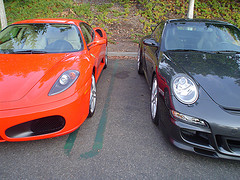Ferrari and Porsche are Italian and German sides of the same coin, respectively.

flickr.com/gfreeman23
Take for instance the passionate Ferrari F430 and the methodical Porsche 911 Carrera 4S. Both cars amaze the driver with their performance while successfully maintaining a respectable amount of practicality, but neither pretends to be anything aside from a sports car.
There are certain attributes every modern sports car should possess. It must be started effortlessly. It must maneuver around town politely and competently. When demanded, it must be able to blast along country roads. It must, both in performance and looks, echo it’s roots on the racetrack while at the same time being perfectly safe on any road.
Since both cars meet and exceed these expectations with self confidence, and all the various intangible qualities are largely decided by personal taste, perhaps the easiest way to compare the two cars is by measuring the facts and figures.
One number that instantly impresses is the Ferrari’s lightning fast 4-second 0-100km/h acceleration. The new generation 4.3-litre V8 pushes out 368 roaring kilowatts, pinning the occupants to their seats. While the Porsche’s acceleration also provides that amusement park ride thrill a super car should deliver, it is 0.8 seconds slower at the 100 km/k mark.
Of course, such acceleration feat isn’t worth much unless the cars also excel in the braking department, which both do. Each car comes with optional ceramic discs brakes, permitting for impressive stopping.
In the engine department, Porsche wins the upper hand. With its more polished motor, Porsche scores points for economy, earning 18.3 liters per 100km while the Ferrari brings up a distant second with a mere 11.8 liters per 100km. Both cars provide the power through impressive 6-speed gearboxes and stay glued to the road with top rate handling performance.
Even if the space is somewhat limited, both the Carrera 4S and F430 offer great interior comfort. Occupants won’t feel claustrophobic or cramped. Although Ferrarri sports an impressive mix of suede, aluminum and carbon fiber, the Italians simply can’t answer the precision fit and finish attained by the Germans.
Significant elements for any super car are speed and silence. The car’s stance and styling draw buyers more than raw numbers. True to its Porsche roots, the Carrera 4S, despite the new proportions, is visually identifiable as a member of the 911 family. While it is definitely a great looking car, somehow the styling no longer creates the jaw dropping reaction that it once did. Even though traditionalists may be adamant that Porsche pay homage to its roots, the truth of the matter is that Ferrari F430 draws the attention and turns heads.
Regardless of whether the Ferrari F430’s stops you dead in your tracks with its appearance, the super car title must go to the Porsche Carrera 4S, which signifies a more complete package.
Tagged with: Ferrari • Porsche • used cars
Filed under: Top Classic Cars